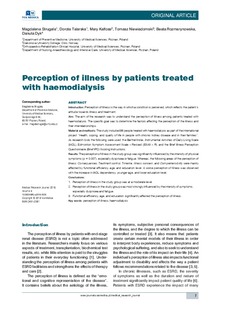| dc.description.abstract | Introduction: Perception of illness is the way in which a condition is perceived, which reflects the patient’s attitude towards illness and treatment.
Aim: The aim of the research was to understand the perception of illness among patients treated with haemodialysis. The specific goal was to determine the factors affecting the perception of the illness and their interrelationships.
Material and methods: The study included 98 people treated with haemodialysis as part of the international project “Health, coping, and quality of life in people with chronic kidney disease and in their families”. As research tools the following were used: the Barthel Index, Instrumental Activities of Daily Living Scale (IADL), Edmonton Symptom Assessment Scale – Revised (ESAS – R), and the Brief Illness Perception Questionnaire (Brief IPQ) Scoring Instructions.
Results: The perception of illness in the study group was significantly influenced by the intensity of physical symptoms (p = 0.007), especially dyspnoea or fatigue. Whereas, the following areas of the perception of illness: Consequences, Treatment control, Timeline, Illness concern, and Comprehensibility were mainly affected by functional efficiency, age, and education level. A worse perception of illness was observed with the increase in IADL dependency, younger age, and lower education level.
Conclusions: 1. Perception of illness in the study group was at a moderate level. 2. Perception of illness in the study group was most strongly influenced by the intensity of symptoms, especially dyspnoea and fatigue. 3. Functional efficiency, age, and education significantly affected the perception of illness. | nb_NO |
